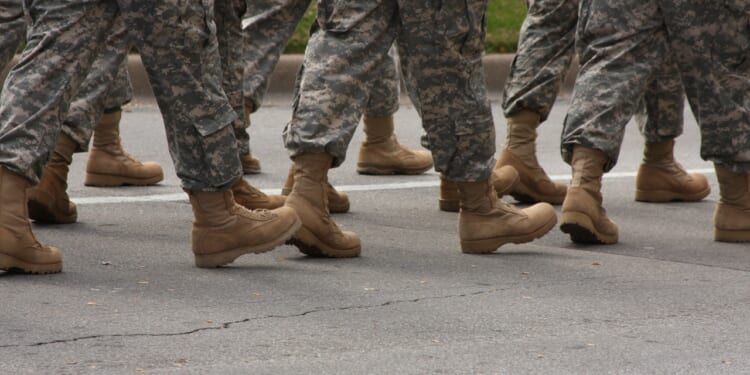
Do America’s ‘Boots on the Ground’ Really Need to Be American?
American jobs are important. But it is equally important to provide the American warfighter with the best boots available, regardless of where they are made.
Today, the expression “boots on the ground” is used to indicate that troops will be deployed to a foreign land and could potentially see combat. It was first attributed to a statement made by General Volney Warner, who served as Commander-in-Chief, United States Readiness Command (USCINCRED), from 1979 to 1981, when discussing the US government’s response to the Iran hostage crisis with a reporter from The Christian Science Monitor in April 1980.
Warner highlighted the difficulties of “getting US combat boots on the ground,” and the idiom stuck, being widely used by military leaders, politicians, and, notably, the press. Yet when the Pentagon looks to put boots on the ground in some distant land, although the troops may be Americans, the boots themselves may not be.
The Free Press reported this week that a large percentage of American military personnel aren’t actually wearing US-made boots. As a result, some lawmakers seek to change that—even if it means that American-made boots could cost more and deliver less!
An Abridged History of Combat Boots
The French Emperor Napoleon may or may not have suggested that an army marches on its stomach, but the average warfighter will disagree. The marching, walking, standing, etc., is very much done with the feet.
Fortunately, combat boot technology has advanced significantly since Napoleon’s era. Until the early 19th century, there was also little difference between military and civilian boots. The first official US military boots were also far from anything special. Known as the “Jefferson Boots” after President Thomas Jefferson, they were introduced in 1816. Although they were laced up and ankle-high, there was no distinction between the right and left foot. That was largely true of civilian shoes as well; it was only during the American Civil War that the concept of specialized shoes for the feet gained widespread adoption.
The US military underwent a variety of boot designs from the latter half of the 19th century to the early 21st century. In that time, the materials have changed and comfort has improved, yet regulations remain in place. The military currently requires combat boots to be eight to 10 inches in height, made of tan or coyote-colored cattlehide leather, with a plain toe and sole that matches the color of the upper. The outsole is typically made of rubber or polyether polyurethane, and the boots can be constructed with all leather or a combination of leather and non-mesh fabric. Many popular footwear brands, such as Nike, Oakley, and Garmont, produce AR 670-1 compliant boots.
However, much of that production doesn’t occur in the United States, and lawmakers are now seeking to change that fact.
Bipartisan Support for American-Made Boots
Lawmakers have introduced an amendment into next year’s defense spending bill. As The Free Press reported, “the amendment was included in the version of the spending bill passed by the House earlier this month, and the Senate will soon consider it.”
The Better Outfitting Our Troops (BOOTS) Act has already garnered bipartisan support, aiming to overturn Pentagon regulations that allow the military to purchase boots made overseas.
“Mandating that all optional combat boots be American made means not only that our troops wear high-quality footwear, it also means we’re reducing our reliance on foreign supply chains, bolstering our defense industrial base and creating good-paying jobs for small and large manufacturers in communities right here at home,” Senator Tammy Duckworth (D-Ill), one of the bill’s sponsors, wrote in a statement in July.
On the surface, this may appear a good move for American businesses, as the United States Department of Defense purchased more than 1.2 million pairs of combat boots in fiscal year 2023 (FY23). Yet, as with many military programs, the reality is far more complex.
The BOOTS Act Is Not a Shoe-In
Reshoring boot-making in the United States is similar to many of the current administration’s policies, which are certainly easier said than done. Some Pentagon officials have even warned that the United States lacks the manufacturing capabilities to increase boot production in the country, and attempting to do so would be time-consuming and expensive.
Part of the problem is the sorry state of American footwear manufacturing in 2025.
“US employment in footwear manufacturing has declined 86 percent since 1980 from over 76,000 jobs to less than 11,000 today, mirroring trends in the apparel industry overall,” The Free Press reported—further noting that in the same timeframe, domestic production of clothing fell from 70 percent to just 2 percent. Half of that is already for the US military.
Yet lawmakers don’t seem deterred, while industry applauded the calls for requiring warfighters to buy (and wear) American. The BOOTS Act has received endorsement from a coalition of American boot makers, which questions why American military personnel are wearing boots made in Vietnam and China. The group argues it undermines military readiness and weakens the US supply chain. But the reality may tell another story.
The Pentagon Should Be Worried About Ships, Not Boots
An argument could be made that this is yet another warning sign that America needs to step up and revive its manufacturing sector. After all, how can the Department of Defense (DoD) return to its “warfighting ethos” if the boots that will be on the ground in a future conflict may have been made in a factory in Asia?
But the solution is also far from an easy one.
The US simply doesn’t have a workforce ready and willing to build the warships the US Navy needs, and that problem is only getting worse. Those are serious problems, to the extent that the US has considered partnering with foreign shipyards to maintain and possibly build the warships the country needs. The coalition of boot makers only supplies around 50 percent of the needs at best.
Concern about where boots are made should seem secondary to worries about warships, even if lawmakers seem convinced otherwise.
The problem runs deeper than where the boots are made. If the US could suddenly start producing more boots, it is unlikely that they could be manufactured as cheaply as the imported versions, raising costs for the Pentagon. Foreign-made combat boots already cost 30 to 50 percent less than domestically-made models. As noted, the US military buys more than 1.2 million annually; those costs would be significant for an already-astronomical defense budget.
Moreover, this may not include the costs incurred by individual service members. Enlisted personnel typically receive one pair of boots as part of their initial military needs, but many opt to buy additional or replacement boots with their uniform allowance. Many service members opt to find something that fits better or is more comfortable. Removing the option to buy foreign will put a strain on warfighters, who are already struggling to make ends meet.
Officers also receive a one-time allowance, and numerous reports have warned that it is typically insufficient to cover all of their initial uniform needs. If the cost of boots increases, service members will have to cover the additional expense.
This is hardly a new debate, either. Under the Berry Amendment, passed in 1941, the military is restricted from buying foreign-made clothing, food, fabrics, and specialty metals if a domestic option is available. There are exceptions for “availability,” and the regulations aren’t strictly enforced yet, but that could easily change.
Individual service members have been allowed to purchase foreign boots, citing availability issues, as comfort is rarely an excuse. Enforcement would limit the options.
The BOOTS Act would take it even further and force service members towards more expensive and potentially even less desirable footwear options. That doesn’t help maintain a “warfighting ethos” and could harm talent retention. Service members who suffer from foot problems aren’t likely to reenlist.
Is the BOOTS Act About Patriotism, National Security—or Money?
Lawmakers like Senator Duckworth, a decorated veteran who lost her legs in combat in Iraq, clearly understands some of these issues. So is the push to “Buy American” about patriotism or something else?
It could be something else.
The Free Press report further warned that the Warrior Protection and Readiness Coalition (WPRC), an association of manufacturers of tactical equipment and material developers, along with other trade groups and American bootmakers, has spent millions of dollars on lobbying efforts. That raises the question of whether this is truly about providing the best boots for the American warfighter or is just another successful lobbying effort.
“Combat boots are the only part of the military uniform not consistently made in America,” Senator Susan Collins (R-Maine) said in a statement. “Closing this gap is critical: not only to protect American manufacturing jobs, but also to ensure the men and women in our military wear uniforms and footwear that live up to the law’s intent and strengthens [sic] our defense supply chain.”
It would be easier to believe that Collins was sincere in her convictions if it weren’t for the fact that New Balance, a member of the WPRC, operates a factory in Norridgewock, Maine.
American jobs are important. But it is equally important to provide the American warfighter with the best boots available, regardless of where they are made.
About the Author: Peter Suciu
Peter Suciu has contributed over 3,200 published pieces to more than four dozen magazines and websites over a 30-year career in journalism. He regularly writes about military hardware, firearms history, cybersecurity, politics, and international affairs. Peter is also a contributing writer for Forbes and Clearance Jobs. He is based in Michigan. You can follow him on Twitter: @PeterSuciu. You can email the author: Editor@nationalinterest.org.
Image: Shutterstock / David Lee.
The post Do America’s ‘Boots on the Ground’ Really Need to Be American? appeared first on The National Interest.

















